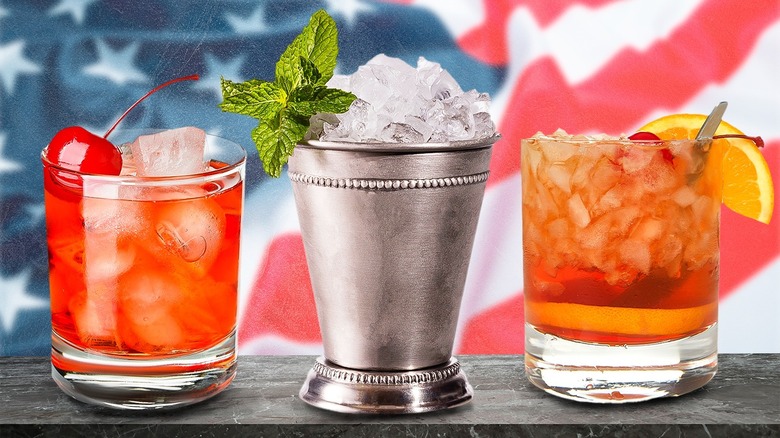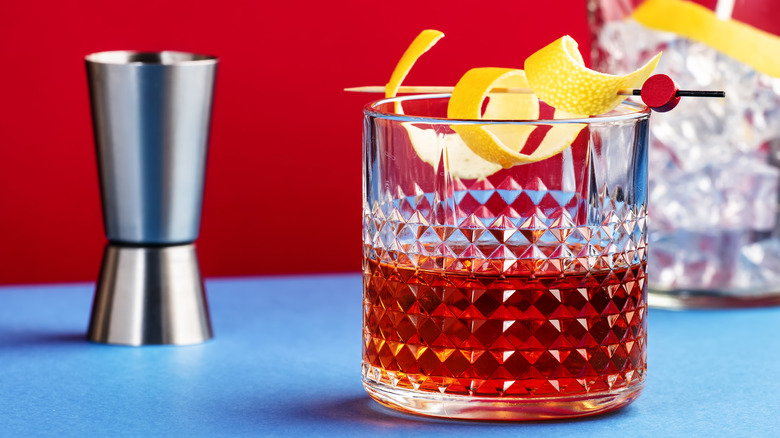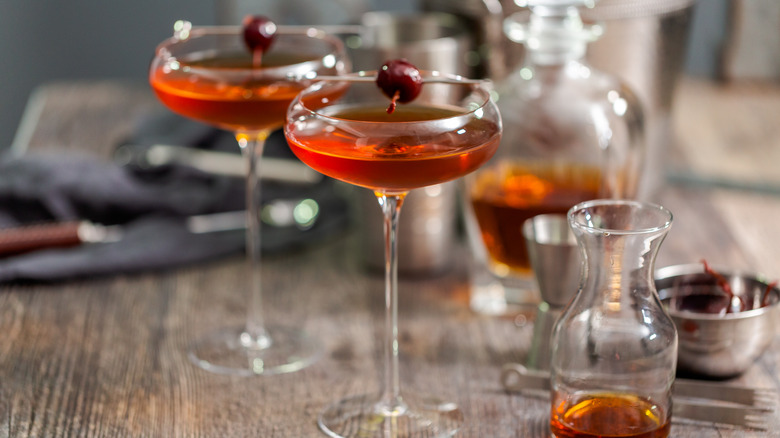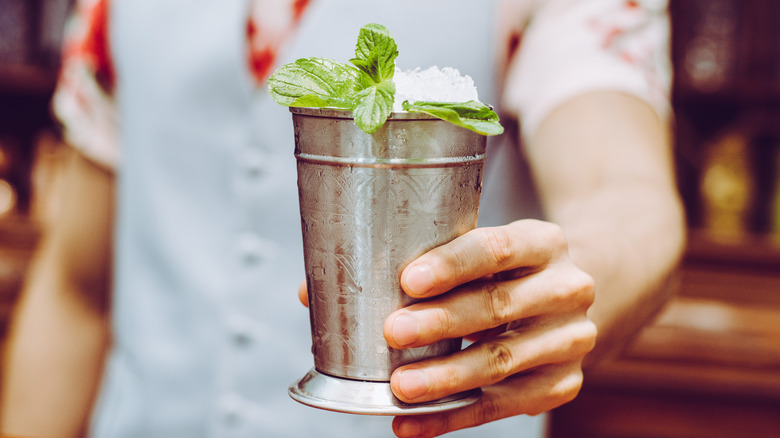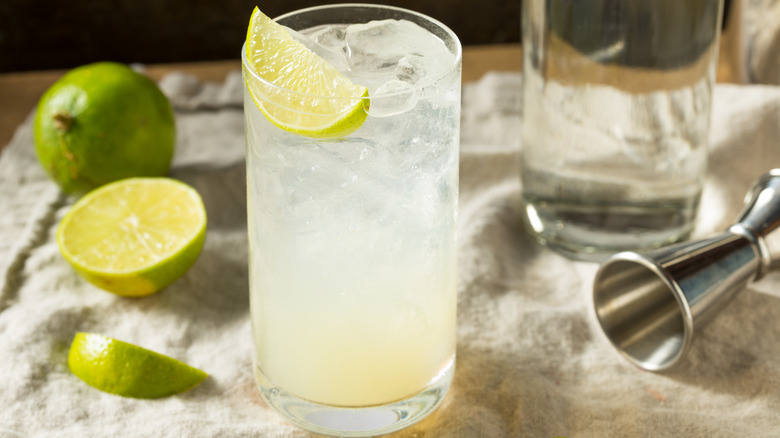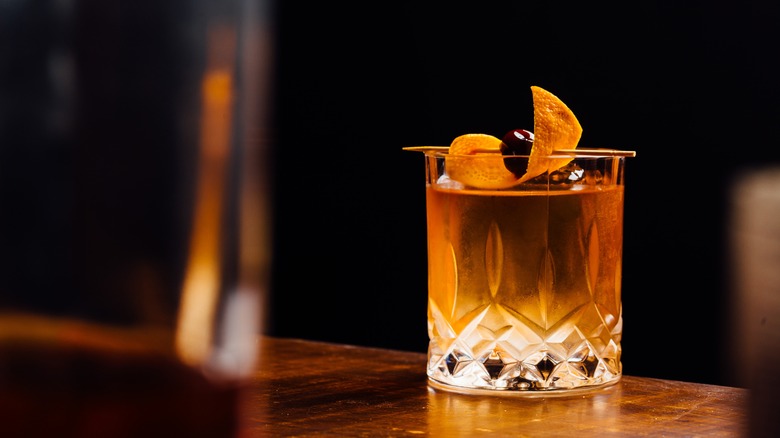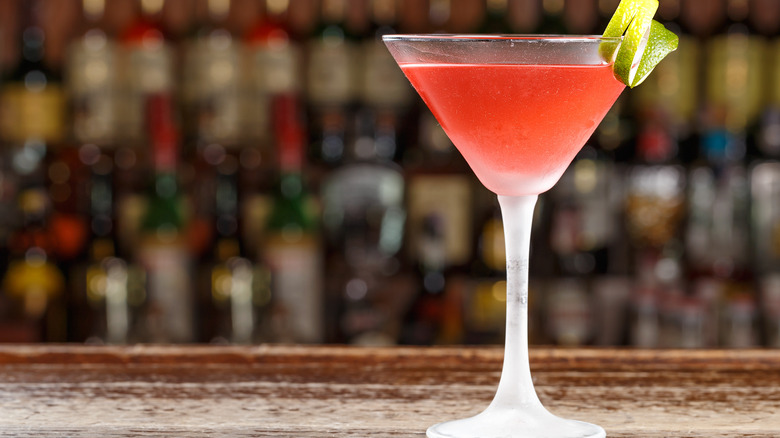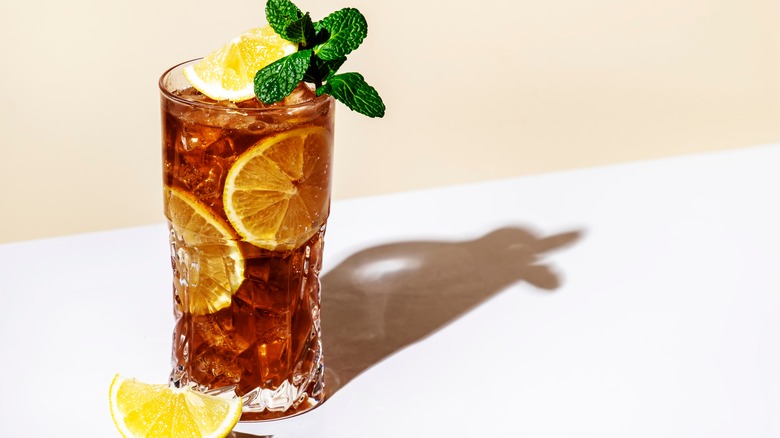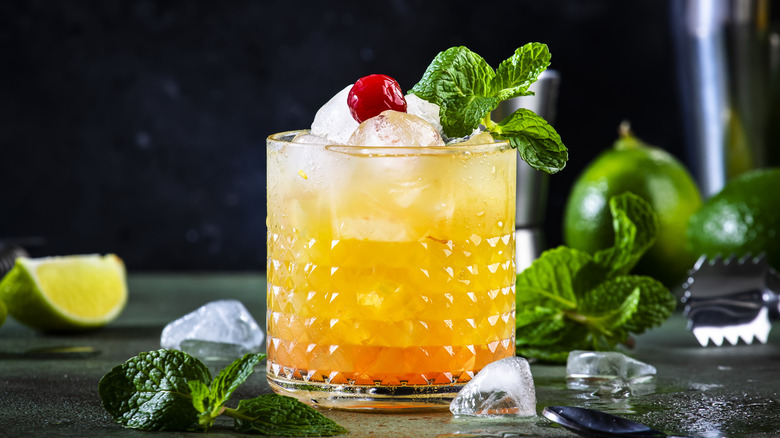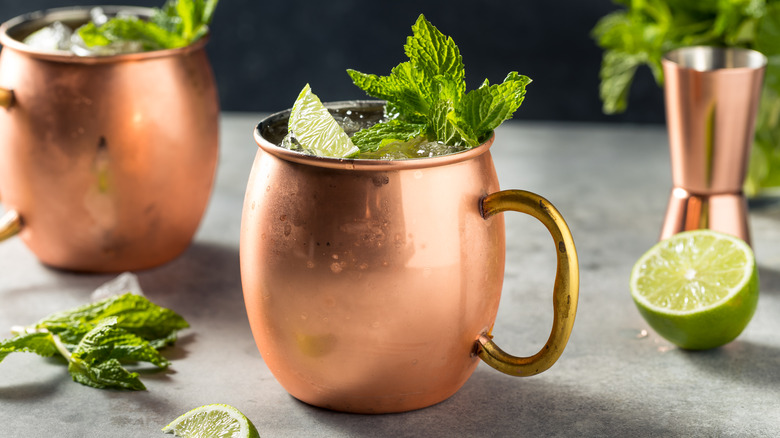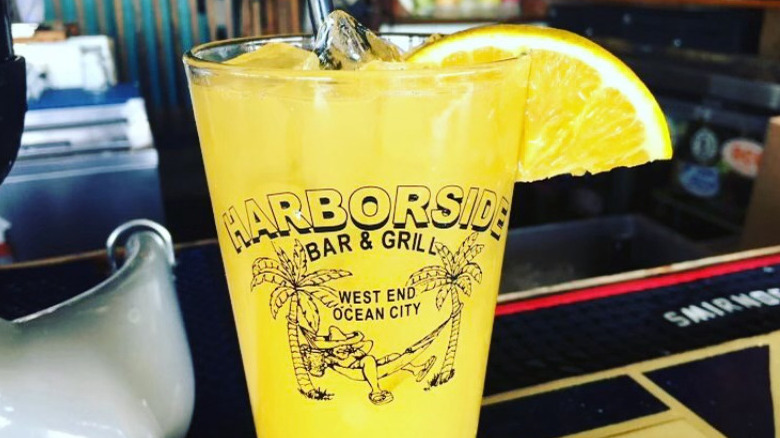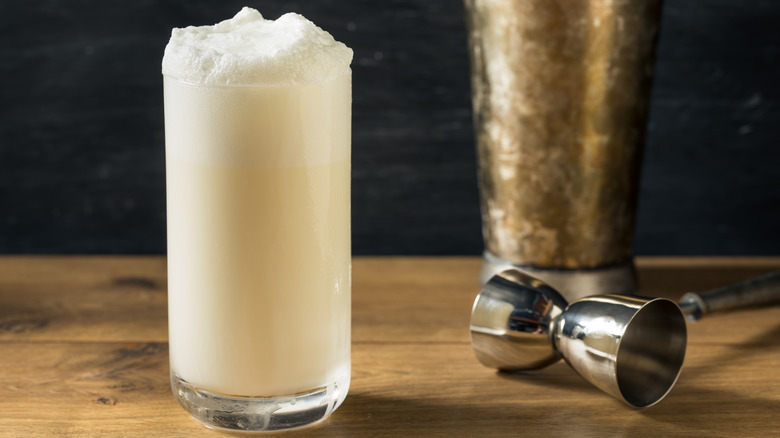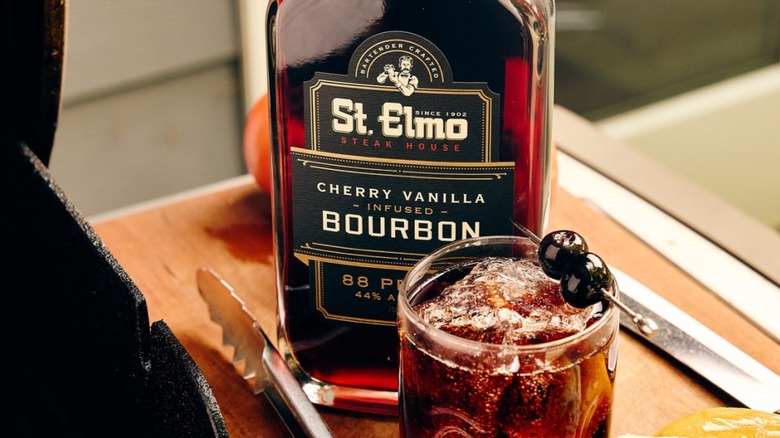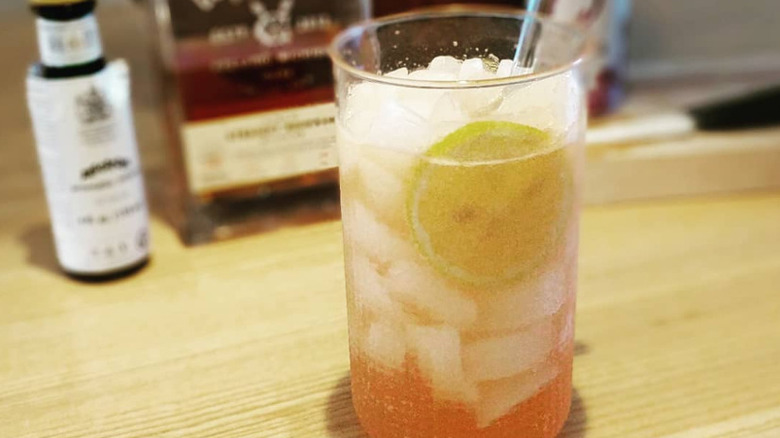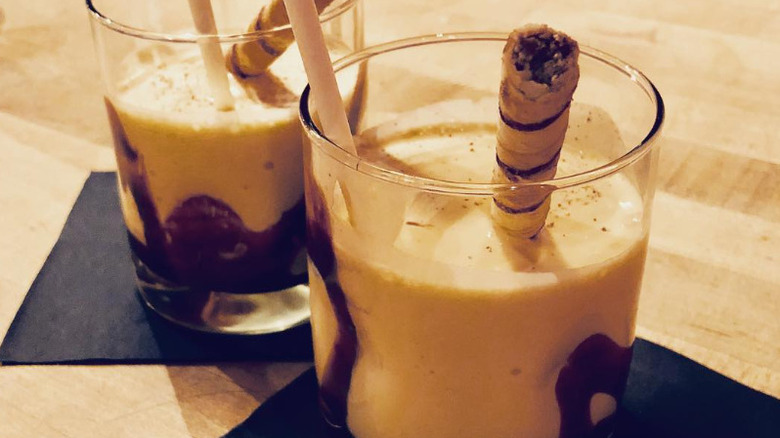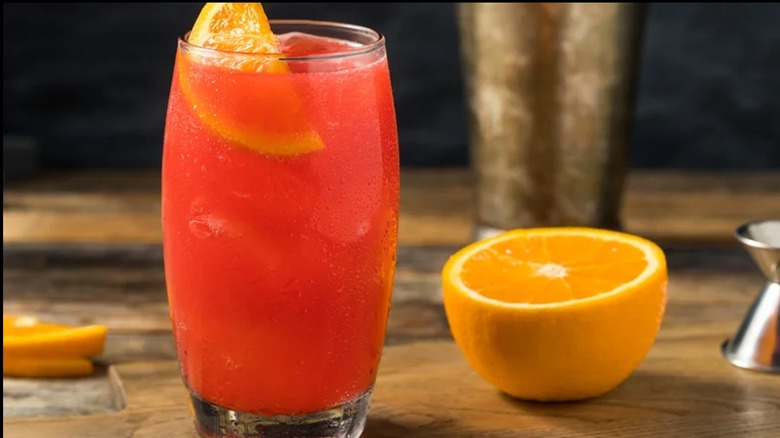15 Cocktails That Were Invented In America
Very few cocktails that were invented in America have a clear cut origin and history. Unless there is a proven paper trail, such as published recipes and photography, most of what is considered proof of origin is hearsay. Recipes are considered "facts" so they cannot be copyrighted. However, cocktail and brand names can be trademarked and photography can be copyrighted. Therefore, claiming the invention of a cocktail is, no doubt, a difficult process mixed in with bartenders' egos and hometown rivalries.
America's favorite cocktails have become popularized by cultural events like the Kentucky Derby, literary works such as "Gone With the Wind", hangouts at the White House held by President Roosevelt, and even desperate marketing attempts to promote Smirnoff. Before going viral was the main way of attracting attention to a new product or recipe, there was never one way to iconize a cocktail. America has a history that's rich in cocktail creation, and these are some originals that tell the story.
Sazerac
The Sazerac is one of the few cocktails invented in America that has an indisputable origin. A French-owned family company had been sending its cognac to New Orleans bars, which became the favorite of local Creole apothecary Antoine Peychaud — also the inventor of their namesake bitters. In 1838, Peychaud invented the Sazerac at his shop, and he named it after one of his favorite French brandy, Sazerac-de-Forge et Fils. It wasn't until the first Sazerac House opened in the 1850s when the Sazerac cocktail started appealing to both tourists and locals.
It's unsure when rye whisky was substituted for cognac, but it is clear that the addition of absinthe started in 1873 when it was added by bartender Leon Lamothe. When absinthe was banned in 1912 for supposedly causing hallucinations, Peychaud's bitters were used in its place and are now included in a standard Sazerac recipe: absinthe, sugar, rye, and Peychaud's bitters.
The state of Louisiana made the Sazerac the official cocktail of New Orleans. Visitors can still order a drink at the Sazerac bar in the Roosevelt Hotel, a local favorite since 1938.
Manhattan
The Manhattan might well be known as the first modern cocktail in America. It had its premier written mention in the "New York Letter" column of The Olean Democrat in September 1882. Two years later, three different versions of a recipe for a Manhattan cocktail were published in three different books: George Winter's "How to Mix Drinks," J.W. Gibson's "Scientific Bar-Keeping," and O.H. Byron's "The Modern Bartenders' Guide."
It was originally thought that the Manhattan was made to celebrate the gubernatorial campaign of Samuel Jones Tilden at the Manhattan Club, as well as to impress Lady Randolph Churchill — the mother of Winston Churchill. It has since been debunked that it was made for Lady Churchill that evening, but it is still possible that the Manhattan Club is where it originated.
Another story is that a New York bartender, John Black, named it after his own bar, the Manhattan Inn, which he ran in the 1860s and 70s. This story comes from an excerpt in 1923's "Valentine's Manual of New York" which mentions the Manhattan cocktail was invented by a man named Black who owned a bar in Lower Manhattan. Regardless of whether it was the Manhattan Club or Manhattan Inn, the classic Manhattan recipe — whisky, vermouth, Angostura bitters, and cherries — is one of the most beloved cocktails in the U.S.
Mint julep
According to "Every Cocktail Has a Twist: Master 25 Classic Drinks and Craft More Than 200 Variations" by Carey Jones and John McCarthy, the mint julep was first noted in print in 1803 as a "dram of spirituous liquor that has mint in it, taken by Virginians in the morning." This became a popular drink made by both enslaved men and freemen trying to earn recognition behind the bar.
For example, in Richmond, Virginia, in the 1850s, bartenders John Dabney and Jim Cook were celebrated for their juleps crafted at the Ballard House hotel. Prior to this, the history of the mint julep shows an emancipated man and bartender named Cato Alexander earned props for his at a Manhattan inn and tavern in the 1830s.
In 1938, the mint julep became the official drink of Churchill Downs, the host of the Kentucky Derby. Today, over 120,000 mint juleps are made during the annual Kentucky Derby event and its classic recipe of bourbon, cane sugar, and fresh mint leaves still remains.
Gin Rickey
Only two cities in the U.S. have an official cocktail. New Orleans is the first with the Sazerac, and Washington D.C. is the second with the gin rickey. Colonel Joe Rickey was a regular at a popular D.C. bar, called Shoomaker's. Eventually, he bought the bar from the original owners. It's unclear whether or not the colonel or his bartender, George Williamson, created the original Joe Rickey cocktail. According to a popular mixologist book, "The Craft of the Cocktail," Rickey did popularize the drink by introducing it along his travels, but it's uncertain the source of the idea.
The name of the cocktail is credited to Col. Rickey's associates, Rep. William Henry Hatch, and Fred Mussey. Roughly 10 years after its original recipe was introduced with bourbon, customers started ordering Rickey's drink with gin instead, making it a national sensation. Like the mint julep, the gin rickey also made an appearance in "The Great Gatsby."
If you're interested in making the original Joe Rickey drink at home, all you will need is bourbon, lime, and mineral water. The gin rickey recipe subs the bourbon for gin. Neither cocktail has added sugar as that was the main request from the colonel when creating the original recipe.
Old fashioned
The old fashioned is considered a descendent of the earliest known cocktail, first made in 1806 to include small ratios of water, sugar, and bitters, and a lot of liquor. However, Charles Browne, author of the 1939 "Gun Club Drink Book," appears to imply that the old fashioned is not the descendent, but in fact itself is the first American cocktail. The addition of fruits and peels is a 20th century addition to the recipe.
The old fashioned cocktail attracts drinkers who like simplicity in their drink. But it also attracts those who like creativity in their cocktails. On its own, the old fashioned cocktail recipe is straightforward in its ingredients: sugar, Angostura bitters, bourbon or rye whiskey, and orange peel for garnish. Those wanting a sweeter recipe may seek to switch out their liquor, up the bitters, or add fruit. As many enterprising bartenders know, herbs and smoke are often brought into the picture, elevating the historic beverage. Not even the glass choice is set in stone.
Cosmopolitan
The cosmopolitan may have hit its cultural apex during the time Carrie Bradshaw used it as her nightly pink crutch. However, a cosmopolitan cocktail recipe was first noted in print back in 1927 — although that recipe is far from what it is today. The original cosmopolitan featured a Scotch whisky, blended Irish whisky, vodka, a Swedish punch liqueur, and both Italian and French vermouth.
Over the years, many other recipes of the same name have been published. However, it's the vodka gimlet that gradually morphed into what we consider the classic cosmopolitan recipe: vodka, Cointreau, juice of a citrus fruit, and cranberry juice for the iconic pink color.
John Caine, a popular bartender in San Francisco, was widely credited in popularizing the cosmopolitan in San Francisco in the 1980s. Caine admitted to Punch that he did not create the cocktail, but instead transported it to San Francisco after seeing the popularity of it in Cleveland, where the gay community had introduced the cocktail as an export from bars that served it in Provincetown. However, a version of the cocktail from San Francisco made its way to the Odeon in New York City where Toby Cecchini, self-credits with inventing the modern-day version of the cosmo which was ordered on a daily basis by pop icon Madonna in the 1980s.
Long Island iced tea
Cocktail enthusiasts know that a Long Island iced tea has not one drop of tea. The origin is also debatable as there is more than one Long Island; Long Island in the Holston River in Kingsport, Tennessee claims that one of its descendants is the inventor of the Long Island iced tea.
A modern Long Island iced tea recipe will feature five different kinds of alcohol — gin, rum, tequila, vodka, and triple sec — plus some lemon juice and cola. According to Visit Kingsport, Charles Bishop created the recipe of vodka, rum, gin, tequila, whisky, and maple syrup, which created the look of a soft drink during the Prohibition era. In the 1940s, Bishop's son added lemon, lime, and cola.
However, another plausible origin is when Bob Butt, a bartender at the Oak Beach Inn East in New York, took on a challenge in the 1970s to create a cocktail with orange-flavored liqueur. He won the contest with his creation — gin, rum, tequila, sour mix, and cola — and called it the Long Island iced tea due to iced tea's popularity in the area. While it's true that Bishop created Tennessee's version first, whether or not that inspired the modern cocktail recipe is unknown.
Mai tai
The mai tai is yet another cocktail with a disputed origin story. Popular Bay Area bartender, Victor J. Bergeron, aka Trader Vic, set out to create a recipe that highlighted a 17-year-old J. Wray and Nephew Jamaican rum. His simple cocktail recipe added lime, orange curaçao, a "rock candy" syrup, and orgeat to a chosen rum.
Eater reports that friendly validation resulted in the name. Bergeron made and presented the cocktail to visiting Tahitian friends, they exclaimed, "Maita'i roa a'e," which translates to "out of this world! The best!" Bergeron shortened this statement to name the cocktail the "mai tai."
It wasn't until 1954 when Bergeron was asked to add juice to the cocktail to make it more tourist-friendly for the Royal Hawaiian Hotel in Waikiki. Fellow bartender Donn "Don the Beachcomber" Beach claimed Bergeron was inspired by the Q.B. Cooler, a drink from Beach's bar that contained twice as many ingredients as the mai tai. It wasn't until both Bergeron and Beach produced a mai tai mix for grocery stores that Bergeron sued Beach in 1970 and won.
Moscow mule
When restaurant owners have an abundance of a single ingredient, it's common for chefs and bartenders to create recipes just to move product. Add that with a dash of savvy marketing, and this is may be why the the Moscow mule became popular. In the 1940s, marketing and product availability coincided for two men: Jack Morgan, owner of the Los Angeles-based British pub, Cock 'n' Bull and John G. Martin, a marketing agent from Heublein drinks company, which owned rights to Smirnoff vodka. Martin was looking to sell vodka, while Morgan was sat with too many cases of unpopular ginger beer.
By leveraging new camera technology of the time, Martin showcased instant photographs of the cocktail, and it quickly became a trend. However, the origin is still murky. The bartender who worked at Cock 'n' Bull at the time, Wes Price, also claims the recipe as he told the Wall Street Journal in 2007. In Price's word, the drink was made to move product.
With the popularity of the Moscow mule, vodka became more popular in the States, and Smirnoff became the brand of choice for the mule for decades. At its simplest, the Moscow mule recipe is still a crowd favorite with a short list of only vodka, ginger beer, and lime juice.
Orange crush
The orange crush is one of the newer cocktails on this list as its recipe was created in 1995. Due to its recent addition to cocktail history and hyperlocal popularity, its origin is simple to track down. The first orange crush was made at Harborside Bar & Grill, a waterside restaurant in West Ocean City.
The beloved recipe is an uncomplicated combination of the juice of one crushed orange, two ounces of orange vodka, triple sec, splash of Sierra Mist, and cubed ice. Other restaurants in town will make versions with oddly-shaped ice cubes, other fruits like grapefruit or cranberry, or replace vodka with other liquors like bourbon.
No matter how many restaurants have added an orange crush to the menu, the fandom hasn't taken the sales away from Harborside; it's only increased the popularity of the drink overall. While the orange crush may not have recognition from the state or city just yet, it is widely considered to be Baltimore's unofficial drink of the summer.
Ramos Gin Fizz
Originally called the New Orleans Fizz, the Ramos Gin Fizz was invented in 1888 by Henry C. Ramos, a preacher by day and bartender by night at the Imperial Cabinet Saloon. The Ramos Gin Fizz can be likened to a sparkling version of a sour, though it is much more. The standard recipe you will find now contains lemon juice, lime juice, gin, simple syrup, egg white, cream, and orange flower water.
Because it is a cocktail with egg whites, it needs extra agitation to create the iconic texture and foam. In the 1800s, it was rumored that every cocktail needed shaking for 15 minutes. And while that length of time is certainly exaggerated, Ramos did hire additional "shaker boys" to help with the agitation of the Ramos Gin Fizz.
While invented in the late 1800s, it wasn't until 1935 when Louisiana Senator Huey P. Long visited the Hotel New Yorker to use it as a publicity backdrop. There the hotel's bartender made the senator the Ramos Gin Fizz. The senator loved it so much that he incorporated the cocktail into his speech pushing against the New Deal.
Elmo cola
The Elmo cola is another hyperlocal cocktail that has an undeniable origin. It wasn't crafted for a competition or to stroke the ego of the owner. The idea for the Elmo cola was the brainchild of a hired hospitality consultant, Tim Kirkland, who had been hired to train the restaurant staff of St. Elmo Steak House in Indianapolis. Craig Huse, the co-owner, and his father asked Kirkland for some cocktail ideas and loved one of the pitched ideas so much that they added it to their cocktail menu as the Elmo cola.
The Elmo cola quickly became a top-selling cocktail, possibly because it tastes like "an adult cherry Coke," Bryn Jones, vice president of marketing and retail at Huse Culinary told Punch. The recipe includes Maker's Mark bourbon infused with vanilla beans, whole cherries, cherry juice, and Coca-Cola. Due to the popularity of the cocktail, Huse Culinary has since launched a canned version with Cardinal Spirits. Beyond a few small tweaks to make it shelf-stable, the canned recipe's main difference is that it uses an 88-proof bourbon.
Horsefeather
If you were a local of Lawrence, Kansas or Kansas City in the '90s, it was likely you enjoyed a horsefeather. While its surge in popularity was as recent as when Green Day and Alanis Morissette dominated the airwaves, its original inspiration — the horse's neck cocktail — dates back as early as the 1800s.
The first mention of the cocktail as the horsefeather only goes back to 1991 in Gary "Gaz" Regan's "The Bartender's Bible." The horse's neck cocktail recipe includes bourbon, Angostura bitters, and ginger with a decorative loopy lemon peel as a garnish; the horsefeather's recipe consists of whiskey, ginger beer, a few dashes of bitters, and a spritz of citrus.
The only proof that the horsefeather might have roots in Kansas City is that a recipe for a cocktail called the Bradley Martin Highball was published in the Kansas City Star in 1898 that called for whiskey, a dash of orange bitters, ginger ale, and a peel of lemon, as well as referenced a bar in Kansas City. While the origin might have some inspiration from this recipe, the modern recipe is no doubt supported by professionals that its origin is Lawrence.
Hummer
The Hummer has a sweet origin story. It is not one of necessity to clear product, or of a recipe that evolved over a hundred years. Bartender Jerome Adams was experiencing a slow day at their workplace, Detroit's Bayview Yacht Club, and decided a cold winter day was the ideal time to break out the blender and make a new iced drink. There they created a drink made with white rum, Kahlua, vanilla ice cream, and a couple of ice cubes.
Adams said in an interview with Punch in 2017 that he got the name of the drink from his friend when they said, 'You know, after two of these, it kinda makes you want to hum.'" The Hummer, now Michigan's state drink, is often sold by the pitcher and Adams was the unofficial ambassador for the drink until him death in 2018. It is to no one's surprise that the Hummer has become beloved around the state as the ice-cream-based cocktail seems to intrigue everyone from milkshake-loving elders to cocktail enthusiasts.
Alabama Slammer
Some classic cocktails were born in upscale Manhattan establishments or historic D.C. bars that date back to the 1800s. And others were born in the 1970s, aka the cocktail dark ages, in a Tuscaloosa bar that catered to University of Alabama students and sports fans.
The Alabama Slammer is made with Southern Comfort liqueur, sloe gin, amaretto, and orange juice and is claimed to have been created at Harry's Bar. The cocktail is usually associated with partying as it is commonly ordered by the shot or pitcher.
The cocktail made its official debut in the 1971 edition of the "Playboy Bartender's Guide" with a slightly different recipe of Southern Comfort, amaretto, sloe gin, and lemon juice — and it's to be noted that this was a year before Harry's opened. But it wasn't until Tom Cruise's speech in the 1988 film "Cocktail" that the Alabama Slammer hit mainstream popularity.
